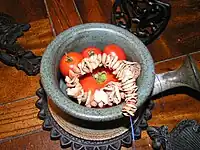| Marasmius oreades | |
|---|---|
_Fr_112276.jpg.webp) | |
| Scientific classification | |
| Domain: | Eukaryota |
| Kingdom: | Fungi |
| Division: | Basidiomycota |
| Class: | Agaricomycetes |
| Order: | Agaricales |
| Family: | Marasmiaceae |
| Genus: | Marasmius |
| Species: | M. oreades |
| Binomial name | |
| Marasmius oreades | |
| Marasmius oreades | |
|---|---|
| Gills on hymenium | |
| Cap is convex or umbonate | |
| Hymenium is adnexed | |
| Stipe is bare | |
| Spore print is white | |
| Ecology is saprotrophic | |
| Edibility is choice | |
Marasmius oreades, also known as the fairy ring mushroom, fairy ring champignon or Scotch bonnet, is a mushroom native to North America and Europe. Its common names can cause some confusion, as many other mushrooms grow in fairy rings, such as the edible Agaricus campestris and the poisonous Chlorophyllum molybdites.
Distribution and habitat
Marasmius oreades grows extensively throughout North America, especially the east where they are also more diverse,[1] and Europe in the summer and autumn (fall) (June–November in the UK), or year-round in warmer climates. It appears in grassy areas such as lawns,[1] meadows, and even dunes in coastal areas.
May to October in Pennsylvania or Mid Atlantic (pg 38).[2]
Description
Marasmius oreades grows gregariously in troops, arcs, or rings (type II, which causes the grass to grow and become greener). The cap is 1–5 centimetres (1⁄2–2 inches) across; bell-shaped with a somewhat inrolled margin at first, becoming broadly convex with an even or uplifted margin, but usually retaining a slight central bump- an "umbo"; dry; smooth; pale tan or buff, occasionally white, or reddish tan; usually changing color markedly as it dries out; the margin sometimes faintly lined.[3]
The bare, pallid, and tough stem[1] grows up to about 2–6 cm (1–2+1⁄2 in) tall and 2–6 mm (1⁄16–1⁄4 in) in diameter.[4]
The gills are attached to the stem or free from it,[3] fairly thick and spaced apart, and white or pale tan, with a cyanide-like odor[1] and dropping a white spore print. The spores measure 7–10 μm × 4–6 μm; they are smooth, elliptical, and inamyloid. Cystidia absent. Pileipellis without broom cells.[3]
Edibility

Marasmius oreades is a choice edible mushroom.[5] Its sweet taste lends it to baked goods such as cookies. It is also used in foods such as soups, stews, etc. Traditionally, the stems (which tend to be fibrous and unappetizing) are cut off and the caps are threaded and dried in strings. A possible reason why this mushroom is so sweet-tasting is due to the presence of trehalose, a type of sugar that allows M. oreades to resist death by desiccation.[6] When exposed to water after being completely dried out, the trehalose is digested as the cells completely revive, causing cellular processes, including the creation of new spores, to begin again.
According to Bill Russell, the mushroom has a firm, chewy texture, and a rich, meaty, spicy flavor. Mushrooms can be stored dry (pg 37).[2] Mycologist David Arora says that it is "one of the few LBM's" worth learning".[7]
Similar species
This mushroom can be mistaken for the toxic Clitocybe dealbata or C. rivulosa, which have closely spaced decurrent gills.[4] The latter lacks an umbo, and is white to grey in color.
Some species of the Collybia, Marasmiellus, Micromphale, and Strobilurus genera are also similar, sometimes requiring microscopic analysis to differentiate.[1]
References
- 1 2 3 4 5 Trudell, Steve; Ammirati, Joe (2009). Mushrooms of the Pacific Northwest. Timber Press Field Guides. Portland, OR: Timber Press. pp. 113–114. ISBN 978-0-88192-935-5.
- 1 2 Russell, Bill (2006). Field guide to wild mushrooms of Pennsylvania and the Mid-Atlantic. University Park, Pa. ISBN 0-271-02891-2. OCLC 64510388.
{{cite book}}: CS1 maint: location missing publisher (link) - 1 2 3 Marasmius oreades (MushroomExpert.com)
- 1 2 Davis, R. Michael; Sommer, Robert; Menge, John A. (2012). Field Guide to Mushrooms of Western North America. Berkeley: University of California Press. pp. 27, 188–189. ISBN 978-0-520-95360-4. OCLC 797915861.
- ↑ Miller Jr., Orson K.; Miller, Hope H. (2006). North American Mushrooms: A Field Guide to Edible and Inedible Fungi. Guilford, CN: FalconGuide. p. 196. ISBN 978-0-7627-3109-1.
- ↑ Marasmius oreades, the fairy ring mushroom, leprechaun. Tom Volk's Fungus of the Month for March 2003
- ↑ Arora, David (1986). Mushrooms demystified: a comprehensive guide to the fleshy fungi (Second ed.). Berkeley: Ten Speed Press. ISBN 978-0-89815-169-5.
External links
 Media related to Marasmius oreades at Wikimedia Commons
Media related to Marasmius oreades at Wikimedia Commons